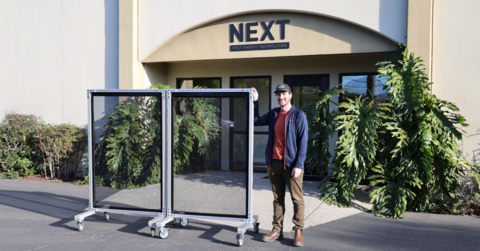
They are a testament to the scalability of NEXT’s technology using automated slot-die coating manufacturing techniques.
This pilot production marks a significant step towards enabling the glass industry to produce full-scale vision area glass for clean, solar energy-producing facades.
NEXT OPV coatings address the three big challenges to creating a scalable solution for the commercial glass industry: aesthetics, performance, and manufacturability. The neutral grey coating, modeled after the most adopted color in North American commercial facades, is combined with power generation and in-line manufacturing to make a first-of-a-kind solution for the glass industry.
“The combination of highest quality aesthetics, power generation, and integration with the glass supply chain is a game changer in the push towards designing Net Zero buildings,” stated Andy Cohen, Gensler Co-Chairman. “Just mid-last year, we were demonstrating NEXT’s 27” x 35” OPV windows at our office in LA, and with this larger window format, we have sustainable building projects in our sights.”
NEXT is preparing demonstration installations with key US and European partners while focusing on shifting from pilot to production scale and obtaining UL safety and performance certification for grid-connected projects.
“This milestone is further evidence to an industry hungry for a solution that our combination of OPV coatings and advanced manufacturing processing is working, scaling, and can be rapidly deployed,” said Daniel Emmett, Co-Founder, Executive Chairman, and CEO of NEXT. “It’s a proof point that builds high confidence in our path to enabling 60” x 120” commercial production.”
NEXT’s proprietary transparent organic photovoltaic (OPV) coating can transform commercial windows into clean energy-generating facades, making buildings more sustainable and resilient and alleviating strain on the grid.
A building with NEXT OPV facades can produce significant onsite renewable power, offsetting 20% to 25% of a typical commercial building’s energy load. The windows also absorb and convert infrared light, reducing the building’s HVAC demands.

